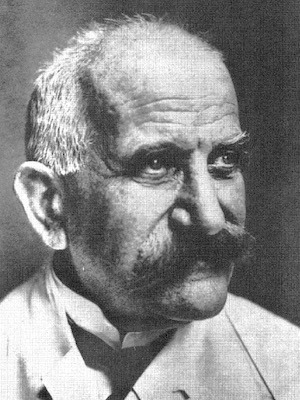Josef Jadassohn

Josef Jadassohn (1863-1936) was a pioneering German dermatologist who had a vast influence on the dermatological field during the 19th and 20th century.
By the end of his career, he was considered the international authority on most aspects of dermatology and venereology of the time, and has been referred to as the “King of Dermatology” of the 1920s. He notably edited the famous Handbuch der Haut- und Geschlechtskrankheiten (Handbook of Skin and Venereal Diseases) – considered one of the most comprehensive textbooks of dermatology ever published.
Jadassohn also gave original descriptions of several entities including nevus sebaceous, granulosis rubra nasi, pachyonychia congenita, and is often referred to as the ‘father of patch testing,’ due to his work in developing such techniques to diagnose contact dermatitis. Eponymously, he is remembered for several dermatological conditions which were often named after himself and his assistants.
Jadassohn was notably involved in sociologic studies involving the legal regulation of prostitution and in prevention of venereal disease. He leaves a legacy in mentoring several notable dermatological figures, including Felix Lewandowsy, Wilhelm Lutz, Max Jessner, Hand Biberstein, Hermann Pinkus and Marion Sulzberger, Stephan Epstein, Karl Linser, Helen Ollendorff-Curth, and Hermann Werner Siemens.
Biography
- Born on September 10, 1863 in Liegenitz, Schleisen (today Legnica, Poland) to a Jewish family.
- Primary and Secondary education at Leignitz
- 1886: Graduated medical school, having attended schools at Göttingen, Breslau, Heidelberg, and Leipzig
- Following graduation offered a dermatology residency position by Albert Neisser (1855-1916). Though originally interested in pathology, he accepted due to his belief that “general pathological questions could be fruitfully studied in the field of dermatology”.
- 1887-1892 Assistant to Neisser in the dermatology clinic of the University of Breslau. He made significant contributions during this time in the areas of syphilis, gonorrhoea, tuberculosis of the skin, atrophy of the skin and in histopathologic investigations of cutaneous diseases.
- 1892-1896 Chief of dermatologic division of the Allerheiligen Hospital, Breslau
- 1896-1917 Chair of Dermatology at University of Bern, Switzerland
- 1896 – Married Margarete Kern
- 1897 – Birth of Jadassohn’s son Werner Jadassohn (1897-1973), who eventually became chairman of the Department of Dermatology at the University of Geneva
- 1904 – Birth of Jadassohn’s daughter, Hilde Jadassohn
- 1913 – Cofounder and first vice president of the Swiss Society of Dermatology and Venereology
- 1917-1930 Professor of Dermatology at Breslau University
- 1922 Succeeded Alfred Blaschko (1858-1922) as chairman of the German Society for the Fight Against Venereal Diseases and largely contributed to the promulgation of the Law for the Fight Against Venereal Diseases that was enacted in 1927.
- 1928 – Chairman of the syphilis commission of the League of Nations; secretary and treasurer of the German Dermatological Society
- 1935 – Honorary member of the Royal Society of Medicine
- Died on March 24, 1936, in Zurich, following complications from an abdominal surgery for a new diagnosis of colon cancer.
Medical Eponyms
Jadassohn-Lewandowsky syndrome (pachyonychia congenita) (1906)
Jadassohn Lewandowsky Syndrome is a subtype of Pachyonychia Congenita (PC). PC is a rare autosomal dominant dermatological disorder characterized by hyperkeratosis affecting the nails and palmoplantar areas and oral leukokeratosis. It is often subdivided into two major variants, Jadassohn-Lewandowski syndrome (PC-1) and Jackson-Lawler syndrome (PC-2), according to the localization of the mutations in the KRT6A/KRT16 or KRT6B/KRT17 genes, respectively.
Jadassohn Lewandowsky Syndrome, or PC-1, is characterized by hypertrophy and increased curvature of the nails (onychogryposis), usually involving all digits, palmoplantar and extensor hyperkeratosis, follicular keratosis, oral or laryngeal leukokeratosis, acral hyperhidrosis and blisters.
Jadassohn and Felix Lewandowsky (1879-1921) employed the descriptive title “pachyonychia congenita” in their article and in the reports which followed this term was generally used. Their patient was a girl aged 15 years who was admitted to hospital with fungating tuberculosis of the skin. Abnormalities of the nails had been present since birth and she also had unusual keratinisation of the skin and tongue. They mentioned that a younger brother was similarly affected, although the parents and 7 sisters had no skin problems.
The nail plates of all fingers and toes are extremely thick and so hard that they cannot be cut off with scissors, but that the father has to remove them with a hammer and chisel.
The back of the tongue is covered with a thick, adherent, occasionally sharply and irregularly delimited, thick, white coating. Other oral mucosa normal.
Hyperidrosis of the membranous nose, palms and soles
Jadassohn and Lewandowsky 1906

1921 – The aetiology of the condition remained uncertain but the familial nature was firmly established when F. Anderson Murray documented 7 affected persons in 3 generations of a family.
1983 – The phenotype was expanded and the autosomal dominant mode of inheritance was determined by Stieglitz and Centerwall. They published details of a kindred with 17 affected persons in 4 generations and used the conjoined eponym in the title of their article – Pachyonychia Congenita (Jadassohn-Lewandowsky syndrome)
Borst-Jadassohn (épithélioma de) (1904, 1926)
The Borst–Jadassohn phenomenon is today recognised as a morphological finding that consists of the presence of well-defined nests of cells located in the spiny stratum of an acanthotic epidermis.
The first description of such an entity was by Max Borst in 1904, describing a microscopically well-defined nest of atypical keratinocytes within disorganized epithelium in invasive carcinoma of the lip.
In 1926, Jadassohn described a verrucous epithelial neoplasm with similar sharply demarcated nests of cells with small dark nuclei in the epidermis. Although originally considered as a distinct entity (intraepidermal epithelioma of Borst–Jadassohn), it is now regarded as a nonspecific morphological expression that can develop in many benign and malignant tumors such as squamous cell carcinoma, poroma, seborrheic keratosis, Bowen’s disease, actinic keratosis, hidracanthoma simplex and rarely epidermal nevi. It is thus now referred to as the Borst–Jadassohn phenomenon.
Jadassohn-Tièche blue naevus
In 1906, Max Tieche, a pupil of Jadassohn, published “on benign melanomas (‘chromatophoromas’) of the skin—‘blue nevi’. This paper first detailed a series of small dark blue to black spots on the face and extremities, which he called blue nevi. He correctly attributed the blue color to the location of pigment in deep dermis, and its absence in the epidermis and superficial dermis.
Tièche acknowledged that Jadassohn had noted those:
…dark blue spots on the skin as a peculiar finding long ago and used to refer to them, in accordance with the general impression, as ‘blue nevi’.
Tièche 1906
Today, a blue naevus is recognised as a relatively common entity of benign proliferation of dendritic dermal melanocytes that actively produce melanin.
They may be categorised into –
- Common Blue Naevi/ Dendritic Blue Naevi/ Jadassohn-Tieche type: These naevi are usually well demarcated, less than 1cm, slightly elevated, and ranging from blue to black in colour. They are most commonly found on the dorsum of the hands and feet.
- Cellular Blue Naevi: These naevi are more commonly larger >1cm, more elevated (nodule or plaque), most commonly located on scalp, buttocks, sacrum or face.
These often require no intervention, however must importantly be distinguished from nodular melanomas.
Jadassohn-Pellizzari anetoderma
Patch Testing (“Jadassohn-Bloch Technique”)
Jadassohn is often referred to as the father of patch testing. On September 23, 1895, at the 5th Congress of German Society of Dermatology in Graz, Austria, he first presented his findings of an eczematous reaction resulting when previously sensitised patients were exposed to mercurial compounds on intact skin.
Bruno Bloch then expanded his work while working at Basel in 1911 and developed a grading system for patch test reactions. The technique employed today is thus often referred to as the Jadassohn–Bloch technique.
Other Eponymous Terms
- Jadassohn–Dössekker disease (also known as atypical tuberous myxedema)
- Naegeli-Franceschetti-Jadassohn syndrome
- Nevus Sebaceous of Jadassohn
Controversies
- Date of birth varies between 1860 and 1863
Major Publications
- Jadassohn J. Ueber eine eigenartige Form von “Atrophia maculosa cutis”. Verhandlungen der Deutschen Dermatologischen Gesellschaft, 1890-91: 342-58 [Jadassohn-Pellizzari anetoderma][anetoderma]
- Jadassohn J. Bemerkungen zur Histologie der systematisirten Naevi und über “Talgdrüsen-Naevi”. Archiv für Dermatologie und Syphilis. 1895; 33: 355–372 [Jadassohn-Tièche blue naevus]
- Jadassohn, J. Zur Localisation der systematisirten Naevi. Archiv für Dermatologie und Syphilis. 1895; 33: 373-408
- Jadassohn J, Lewandowski F. Pachyonychia congenita keratosis disseminata circumscripta (follicularis). Tylomata, Leucokeratosis linguae. In: Neisser A, Eduard J. Ikonographia dermatologica. 1906: 29-31.
- Jadassohn J, Marchionini A. Handbuch der Haut- und Geschlechtskrankheiten. Berlin, J. Springer, 1927-37
- Jadassohn J. Demonstration von selteneren Hautepitheliomen. Beitrage zur klinischen Chirurgie, 1926; 136: 345-58 [Borst-Jadassohn]
- Jadassohn J. Zur Kenntnis der medicamentösen Dermatosen. Verh Dtsch Derm Ges. 1895;5:103–129.
References
Biography
- Obituary: Josef Jadassohn (1863–1936). Arch Derm Syphilol. 1936; 33(6): 1063-1069
- Josef Jadassohn (1863-1936) dermatologist. JAMA. 1969; 207(8): 1511‐1512.
- Shelley WB, Crissey JT. Josef Jadassohn. Classics in Clinical Dermatology with Biographical Sketches 2003; 269-271
- Lachapelle JM. Evolution of patch testing. Dermatitis. 2009;20(6):316‐321.
- Beighton P, Beighton G. Josef Jadassohn. The Person Behind the Syndrome. Springer 2012: 95
- Weyers W. Josef jadassohn–an appreciation on the occasion of his 150th birthday. Am J Dermatopathol. 2013;35(7):742‐751.
- Falto-Aizpurua LA, Griffith RD, Nouri K. Josef Jadassohn: a dermatologic pioneer. JAMA Dermatol. 2015;151(1):41
- Bibliography. Josef Jadassohn. WorldCat Identities
- UpToDate: Acquired melanocytic nevi (moles). Title: Blue Nevi. Updated 2022.
- Souza, B. et al. “Dermatoscopy of the Borst–Jadassohn phenomenon in hidroacanthoma simplex”. An Bras Dermatol. 2020; 95(1): 95-97.
Eponymous terms
Jadassohn-Lewandowsky syndrome
- Murray FA. Congenital anomalies of the nails. Four cases of hereditary hypertrophy of the nail bed associated with a history of erupted teeth at birth. Br J Derm 1921; 33: 409-412
- Stieglitz JB, Centerwall WR. Pachyonychia Congenita (Jadassohn-Lewandowsky syndrome): a seventeen-member, four-generation pedigree with unusual respiratory and dental involvement. Am J Med Genet. 1983 Jan;14(1):21-8.
- Al Aboud A, Al Aboud K. Josef Jadassohn (1863-1936), Felix Lewandowsky (1879-1921), and their syndrome. Clin Cosmet Investig Dermatol. 2011;4:179‐182.
- Prasad A, et al. Jadassohn Lewandowsky Syndrome: A Rare Entity. Indian Journal of Dermatology, 2015; 60(5): 524.
- Pachyonychia Congenita Project
Borst-Jadassohn
- Borst M. Über die Möglichkeit einer ausgedehnten intraepidermalen Ausbreitung des Hautkrebses. Verhandlungen der Deutschen Gesellschaft für Pathologie, 1904; 7: 118-123
Jadassohn-Tièche
- Jadassohn J. Bemerkungen zur Histologie der systematisirten Naevi und über “Talgdrüsen-Naevi”. Archiv für Dermatologie und Syphilis. 1895; 33: 355–372
- Tièche M. Über benigne Melanome (“Chromatophorome”) der Haut – “blaue Naevi”. Virchows Archiv fur Pathologische Anatomie und Physiologie und fur Klinische Medizin, 1906; 186: 212-29
Jadassohn-Pellizzari anetoderma
- Jadassohn J. Ueber eine eigenartige Form von “Atrophia maculosa cutis”. Verhandlungen der Deutschen Dermatologischen Gesellschaft, 1890-91: 342-5
- Pellizzari C. Eritema orticato atrofizzante – Atrofia parziala idiopatica della Pelle. Giornale Italiano delle Malattie Veneree e delle Malattie della Pelle 1884; 19: 230-243.
- Schweninger E, Buzzi F. Multiple benigne, geschwulstartige Bildungen der Haut. Multiple benign tumour-like new growths on the skin, in Unna PG, Morris M, Besner E, et al (eds):Internationaler Atlas seltener Hautkrankheiten. International atlas of rare skin diseases. Atlas international des maladies rares de la peau 1889-1899; Vol V, Chapter XV.1, Plate 15; 2-7 and Plate XV [Schweninger-Buzzi Syndrome]
- Kineston DP, Xia Y, Turiansky GW. Anetoderma: a case report and review of the literature. Cutis. 2008 Jun;81(6):501-6
- Venencie PY, Winkelmann RK, Moore BA. Anetoderma. Clinical findings, associations, and long-term follow-up evaluations. Arch Dermatol. 1984 Aug;120(8):1032-9.
Patch Testing
- Jadassohn J. Zur Kenntnis der medicamentösen Dermatosen. Verh Dtsch Derm Ges. 1895;5:103–129.
BSc, MD from University of Western Australia. Junior Doctor currently working at Sir Charles Gairdner Hospital.

